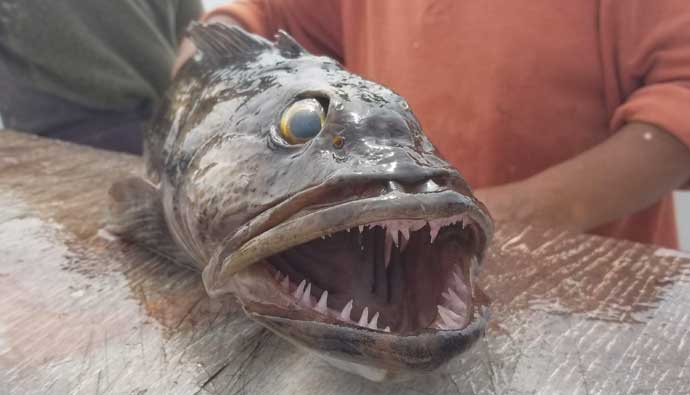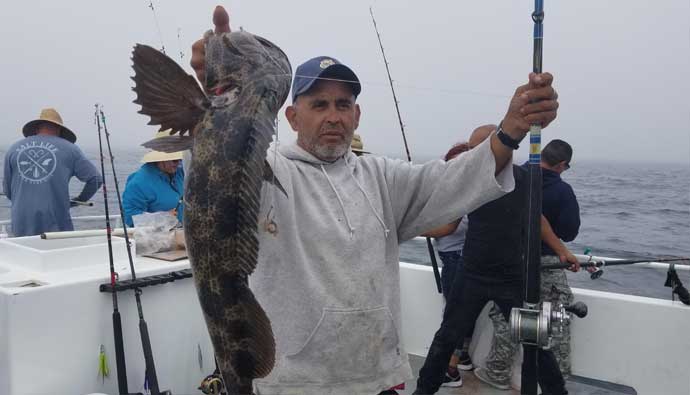Lingcods look like a fish from your nightmares. They have fangs for teeth and weird bluish meat color.

However, they can be challenging to hook up and land, but if you do, they provide great table fare.
In this guide, you’ll learn everything you need to bring home a keeper lingcod!
Overview
Lingcod is known as the cultus cod, blue cod, buffalo cod, green cod, and the ling fish. This fish is a Pacific marine species that belongs to the Hexagrammidae family. Contrary to what its name implies, it is not a true cod.
It is also known as the cultus cod or false cod because of this and it can be found on the west coast of North America and off the coast of British Colombia.
Lingcod Facts
The body of the lingcod is smooth, and it has a long dorsal fin that runs along its body. It has a large mouth and pectoral fins, and the adults are distinguishable due to their massive jaws and pointed teeth.

This highly prized sport fish can grow up to 50 inches or longer, but they do not grow more than 3 feet in length. Females are larger than males and juvenile or baby lingcod have smaller and more slender bodies.
The ling cod is usually brown or grey, and some blotches have blue or orange outlines. The color of the outline depends on the habitat. Since it is a prized sport fish, the ling is has a history of being overfished.
| Scientific Name: | Ophiodon elongatus |
| Common Name(s): | Bluefish, buffalo cod, blue cod, cultus cod, green cod, lincod, ling fish |
| Family: | Hexagrammidae |
| Characteristics | Large mouth and large pectoral fins. Adults have pointed teeth and large jaws. Brown or grey in color with blotches that are outlined in orange or blue. |
| Depth Range | 32 to 328 feet |
| Fishing Information | It has a long history as a food fish that spans 5000 years and they were fished by early settlers in the mid-1800s. |
| Catch & Size Limits | Check your local regulations |
How to Fish for Lingcod

There are a number of tackle rigs that you can use to catch this legendary sport fish. Let’s cover a few that have shown success.
Blue Lingcod Jigs
One of the best rigs for catching ling cod is the Norwegian cod jig.
[amazon box=”B00FM832B4″]
If you can take this jig down to around 100-200 feet deep, you’ll be surprised how effective it handles hooking up with ling cods.
It’s a massive 12 inches in length and has large treble hooks. What’s great about such jigs is that they look like wounded herring and also the light glinting off the metal attracts the fish from the deep as well. Plus, since these jigs are quite heavy, they plummet to the bottom fast and can remain there vertically even if your boat is on the move.

These are also great because even in current, they tend to remain vertical when hanging from the boat.
Shiny silver or metallic jigs are more attractive to lingcod than other varieties because of the reflective surface. Once the fish is hooked, you need to pull hard to get it out of its rocky hiding hole. You can also use large plastic grubs or swimbaits, but only if you are fishing from the shore – these can get dislodged in deepwater currents.
Ling Cod Fishing Tactics
- Lower your Norwegian jig down to the bottom, then reel up a few turns to prevent it from getting snagged. Then jig like crazy!
- On the drop, get ready, as lingcod tends to hit them as it goes down.
- A powerful hookset is recommended.
- Drop the bait slowly in the water to avoid tangles, and crank up a little when you feel it reach the bottom.
- The farther north you go, the larger the lingcod gets.
- Lingcod can grab onto hooks or bait violently or subtly but don’t be hasty in grabbing the rod. Retrieve it slowly and at a steady pace because the fish may only have a death grip on the bait and not the hook.
Catching Lingcod in Four Seasons
Lings are not particularly migratory, and they are available throughout the year in all four seasons, but you can only catch one per day as per regulations. However, the best time to fish for lingcod is when it is spawning. Lingcod occupies rocky areas at depths of over 32 to 328 feet.
In October, the fish migrates to spawning grounds, where the males set up nests in areas that experience strong currents. Spawning takes place in late winter and early spring, and the larger females leave the nest sites as soon as they are done depositing their eggs.
Spearfishing Lingcod

Spearfishing for lingcod can be challenging as most of the time. They are held up between the rocks. When diving makes sure you use a flopper so that you don’t damage your slip tip when you pierce through the fish and hit the rocks.
Since you’ll be looking in holes, make sure you bring a trusted diving flashlight to help you see where the lings are hiding. Even if you’re diving during the day, it’s helpful to bring one along.
If your speargun is making it too easy, try using a pole spear. I tend to like using them more around rocks since you don’t need much power to penetrate the fish, and you can take more shots quicker if you miss.
How to Clean Lingcod Fish
I’m a huge fan of what Taku is doing over at Outdoor Chef Life. Check out his impressive ling cod catch and cook vid!

- Remove the dorsal and anal fins using a very sharp knife or special fish shears. Make sure that you cut as close to the flesh of the fish as possible.
- Slice the tail off and apply force to the butt of the knife to slice through the spine.
- Slice all the way around the center to cut the fish in half.
- To remove the head, first, lift the gills and slice through the thin layer of skin that lies underneath. Slice through the flesh that is behind the head right down to the spine. Do this on both sides. Snap off the head by it off the edge of the cutting board or counter and apply force with the knife.
- To remove the collar, slice behind the pelvic fins and right down to the bone on both sides.
- Cut through the spine by hitting the butt of the knife forcefully.
- Remove the flesh from the spine on both sides.
- To fillet the fish, slice it in half lengthwise. Use the rib bones to guide your knife and to keep the fish steady. Lift the separated flesh with your other hand as you slice. Once you reach the center of the spine, use the knife’s tip to cut along the spine and separate the two halves by tugging it through the rib bones. Make sure the knife is parallel to the cutting board.
- Lay the fish side down and cut around the spine to remove it.

How to Cook Ling Fish
- Brine the lingcod at room temperature for at least half an hour. Drain and rinse before using.
- Preheat the oven to 400°
- Cut a lemon in half and cut the other half into wedges.
- Melt about ¼ cup of butter in a skillet over medium-high heat and cook the fillets in it till they turn golden brown, or 5 minutes per side.
- Place the fillets on a baking sheet and squeeze the half lemon on top.
- Make a mix of bread crumbs, parmesan cheese, and lemon zest in a bowl and cover the fillets with it.
- Bake in the oven till the bread crumbs turn golden brown on top or for 15 to 20 minutes.
FAQs
Lingcod meat is firm, and it has a distinct green or blue color depending on its diet.
Lingcod inhabits colder waters in intertidal zone reefs and kelp beds that have strong tidal currents.
The cause of the rare blue color is due to a pigment called biliverdin, which transforms the blood serum of this fish into rare color.




 Facebook
Facebook YouTube
YouTube








